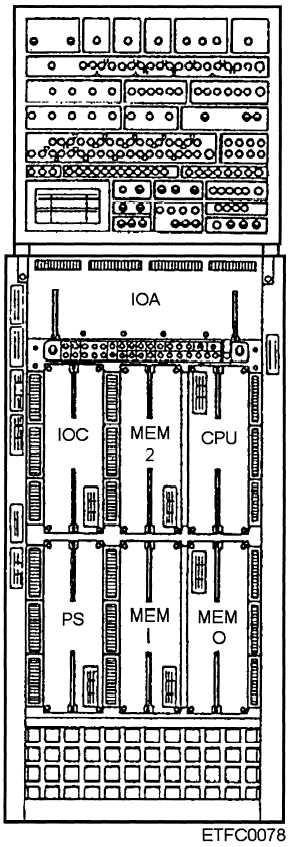and control), categories of I/O operations, and I/O
interfacing.
INPUT/OUTPUT PROCESSOR
For those computers that have an I/O processor, the
physical organization of I/O is similar to the other major
functional areas: CPU and memory. I/O processors can
vary from many pcb’s that makeup a module/unit to a
single pcb. Larger mainframe computers use the
modular arrangement:
multiple components on
multiple pcb’s that comprise one or more modules or
units.
Mini- and microcomputers use chassis or
assemblies, cages or racks, and motherboard/backplane
arrangements.
Minis and micros use multiple
components on one pcb or groups of pcb’s (usually not
more than seven) to form the I/O processor.
The I/O processor controls the transfer of
information between the computer’s main memory and
the external equipments. I/O processors are packaged
two different ways: (1) IOC/IOA modules or multiple
IOC/IOA pcb’s, and (2) I/O pcb’s. Regardless of the
setup, computers with an I/O processor will use some
sort of controller to regulate the signals in the I/O
processor itself (includes IOC/IOA setup) and memory.
IOC/IOA Module or Multiple
IOC/IOA Pcb’s
I/O processors that are packaged as IOC/IOA
modules or multiple IOC/IOA pcb’s are divided into
two sections. The two sections are a single module/unit
or group of pcb’s for the I/O controller (IOC) and a
single module/unit or group of pcb’s for the I/O
adapter (IOA) (fig. 7-2). Mainframes and some minis
use this arrangement.
IOC.— The IOC relieves the CPU of the necessity
to perform the time consuming functions of
establishing, directing, and monitoring transfers with
external equipments.
Data and control signals are
exchanged with external equipments via the IOA. IOCs
communicate by means of a bidirectional bus. An IOC
is provided with a repertoire of instructions
(commands) that varies with the type of computer. The
IOC contains the necessary control and timing circuits
(digital) necessary to function asynchronously with the
CPU and controls the transfer of data between
accessible main memory and the external equipments.
IOC programs are initiated by instructions from the
CPU and executed by a repertoire of IOC commands
stored in main memory. Included in the repertoire are
those commands that establish the conditions for data
7-3
Figure 7-2.—IOC/IOA modules in a single cabinet
configuration.


